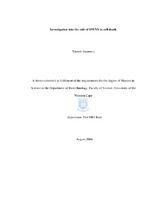| dc.contributor.advisor | Rees, D.J.G. | |
| dc.contributor.author | Seameco, Tumelo | |
| dc.contributor.other | Dept. of Biotechnology | |
| dc.contributor.other | Faculty of Science | |
| dc.date.accessioned | 2013-08-07T12:59:18Z | |
| dc.date.available | 2007/04/30 11:13 | |
| dc.date.available | 2007/04/30 | |
| dc.date.available | 2013-08-07T12:59:18Z | |
| dc.date.issued | 2004 | |
| dc.identifier.uri | http://hdl.handle.net/11394/1853 | |
| dc.description | Magister Scientiae - MSc | en_US |
| dc.description.abstract | Many genes are activated to influence the self-destruction programme of the cell. This programme entails synchronised instigation and implementation of numerous subprograms. The arrival of gene targeting aided in the determining of the functions of novel genes. Such genes may have been sequenced, but not functionally characterised. The fulfillment of this requirement through gene targeting technology has swiftly developed. The mode by which DWNN operate in organisms in which it is thought to be covalently linked to some other proteins, which have a definite role in apoptosis, is not yet unraveled. This study attempted the functional characterisation of DWNN in light to the hypothesis that it may be involved in Cytotoxic T lymphocyte killing and apoptosis. | en_US |
| dc.language.iso | en | en_US |
| dc.publisher | University of the Western Cape | en_US |
| dc.subject | Apoptosis | en_US |
| dc.subject | Cell death | en_US |
| dc.subject | Pathology | en_US |
| dc.subject | Cellular | en_US |
| dc.title | Investigation into the role of DWNN in cell death | en_US |
| dc.type | Thesis | en_US |
| dc.rights.holder | University of the Western Cape | en_US |
| dc.description.country | South Africa | |

